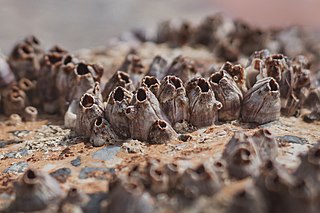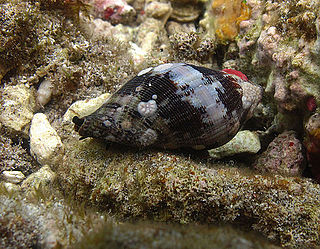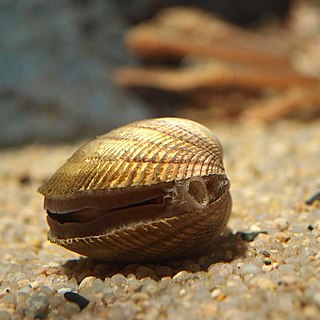
Balanus is a genus of barnacles in the family Balanidae of the subphylum Crustacea.

Jean Guillaume Bruguière was a French physician, zoologist and diplomat.

Aphrodita is a genus of marine polychaete worms found in the Mediterranean Sea and the Atlantic Ocean.

The Terebridae, commonly referred to as auger shells or auger snails, is a family of predatory marine gastropods in the superfamily Conoidea. They have extremely high-spired shells with numerous whorls; their common name refers to the resemblance of their shells to rock-drill bits. More than 400 species are recently known worldwide.

Barbatia is a genus of "bearded" ark clams, marine bivalve mollusks in the family Arcidae, the ark clams.

Concholepas is a genus of medium-sized to large predatory sea snails, marine gastropod mollusks in the family Muricidae, the rock shells.

Cerithium is a genus of small to medium-sized sea snails, marine gastropod molluscs in the family Cerithiidae, the ceriths.

Conus guinaicus is a species of predatory sea snail, a marine gastropod mollusk. It is part of the genus Conus, more popularly known as cone snails, cone shells or cones.

Pusionella is a genus of sea snails, marine gastropod mollusks in the family Clavatulidae.

Pareuthria is a genus of sea snails, marine gastropod mollusks in the family Cominellidae.

Bullia is a genus of sea snails, marine gastropod mollusks in the family Nassariidae, the Nassa mud snails or dog whelks.

Nassa is a genus of sea snails, marine gastropod mollusks in the subfamily Rapaninae of the family Muricidae, the murex snails or rock snails.

Purpura is a genus of sea snails, marine gastropod mollusks in the subfamily Rapaninae of the family Muricidae, the murex snails or rock snails.

Supplanaxis is a genus of small sea snails, marine gastropod mollusks in the subfamily Planaxinae of the family Planaxidae.

Stenomelania is a genus of freshwater snails with a gill and an operculum, aquatic gastropod mollusks in the subfamily Thiarinae of the family Thiaridae known as thiarids.

Arca is a genus of saltwater clams in the family Arcidae, the ark clams.

Fulvia is a genus of cockles, marine bivalve molluscs in the family Cardiidae. Most species are found in the Indo-Pacific and in Australian waters.

Amphinomidae, also known as the fireworms, bristle worms or sea mice, are a family of marine polychaetes, many species of which bear chaetae mineralized with carbonate. The best-known amphinomids are the fireworms, which can cause great pain if their toxin-coated chaetae are touched or trodden on. Their relationship to other polychaete groups is somewhat poorly resolved.
Olivinae is a subfamily of sea snails, marine gastropod mollusks in the family Olividae, the olives.
















